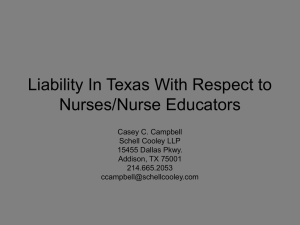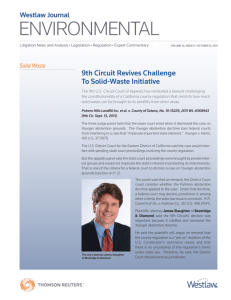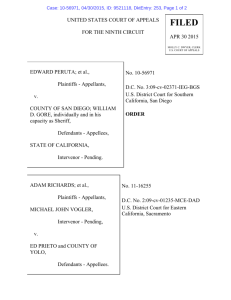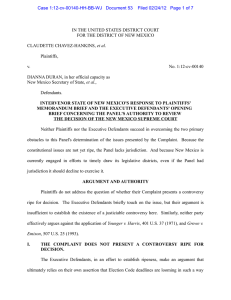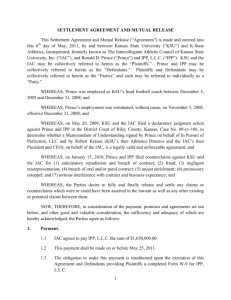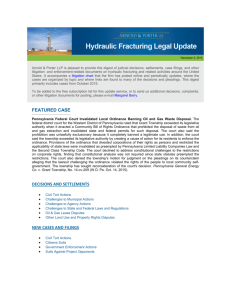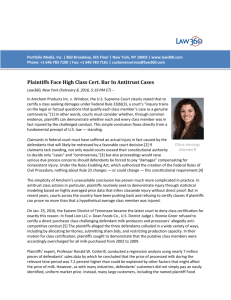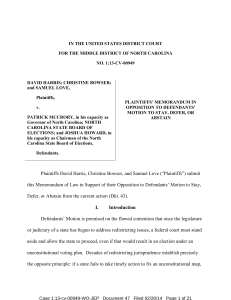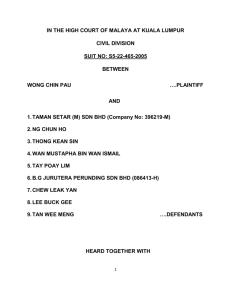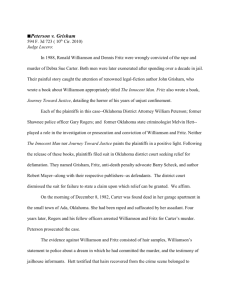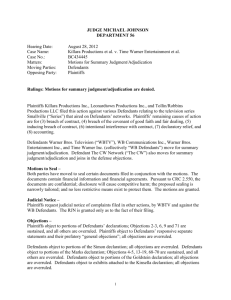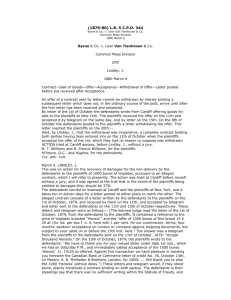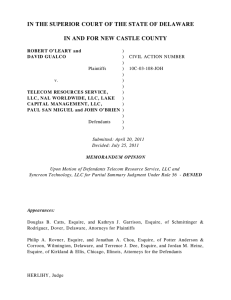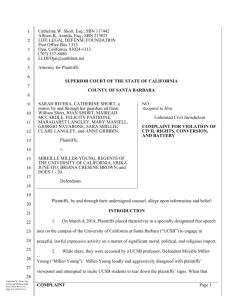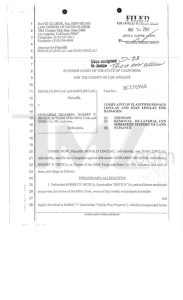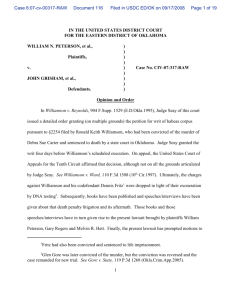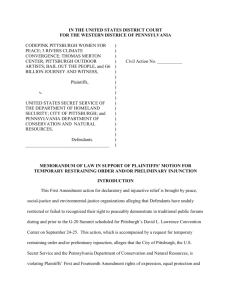BULLET POINTS EXPLAINING WHY E.T. v. TANI CANTIL
advertisement
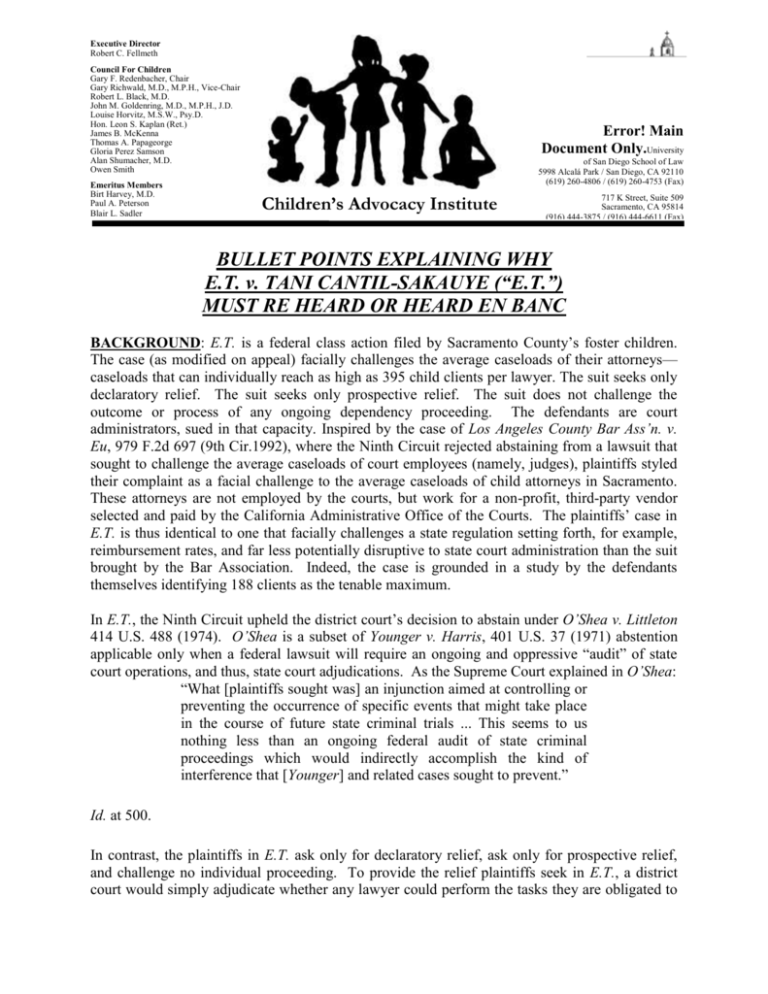
Executive Director Executive Director Robert C. Fellmeth Council For Children Gary F. Redenbacher, Chair Gary Richwald, M.D., M.P.H., Vice-Chair Robert L. Black, M.D. John M. Goldenring, M.D., M.P.H., J.D. Louise Horvitz, M.S.W., Psy.D. Hon. Leon S. Kaplan (Ret.) James B. McKenna Thomas A. Papageorge Gloria Perez Samson Alan Shumacher, M.D. Owen Smith Emeritus Members Birt Harvey, M.D. Paul A. Peterson Blair L. Sadler Error! Main Document Only.University of San Diego School of Law 5998 Alcalá Park / San Diego, CA 92110 (619) 260-4806 / (619) 260-4753 (Fax) Children’s Advocacy Institute 717 K Street, Suite 509 Sacramento, CA 95814 (916) 444-3875 / (916) 444-6611 (Fax) Reply to: □ San Diego □ Sacramento www.caichildlaw.org BULLET POINTS EXPLAINING WHY E.T. v. TANI CANTIL-SAKAUYE (“E.T.”) MUST RE HEARD OR HEARD EN BANC BACKGROUND: E.T. is a federal class action filed by Sacramento County’s foster children. The case (as modified on appeal) facially challenges the average caseloads of their attorneys— caseloads that can individually reach as high as 395 child clients per lawyer. The suit seeks only declaratory relief. The suit seeks only prospective relief. The suit does not challenge the outcome or process of any ongoing dependency proceeding. The defendants are court administrators, sued in that capacity. Inspired by the case of Los Angeles County Bar Ass’n. v. Eu, 979 F.2d 697 (9th Cir.1992), where the Ninth Circuit rejected abstaining from a lawsuit that sought to challenge the average caseloads of court employees (namely, judges), plaintiffs styled their complaint as a facial challenge to the average caseloads of child attorneys in Sacramento. These attorneys are not employed by the courts, but work for a non-profit, third-party vendor selected and paid by the California Administrative Office of the Courts. The plaintiffs’ case in E.T. is thus identical to one that facially challenges a state regulation setting forth, for example, reimbursement rates, and far less potentially disruptive to state court administration than the suit brought by the Bar Association. Indeed, the case is grounded in a study by the defendants themselves identifying 188 clients as the tenable maximum. In E.T., the Ninth Circuit upheld the district court’s decision to abstain under O’Shea v. Littleton 414 U.S. 488 (1974). O’Shea is a subset of Younger v. Harris, 401 U.S. 37 (1971) abstention applicable only when a federal lawsuit will require an ongoing and oppressive “audit” of state court operations, and thus, state court adjudications. As the Supreme Court explained in O’Shea: “What [plaintiffs sought was] an injunction aimed at controlling or preventing the occurrence of specific events that might take place in the course of future state criminal trials ... This seems to us nothing less than an ongoing federal audit of state criminal proceedings which would indirectly accomplish the kind of interference that [Younger] and related cases sought to prevent.” Id. at 500. In contrast, the plaintiffs in E.T. ask only for declaratory relief, ask only for prospective relief, and challenge no individual proceeding. To provide the relief plaintiffs seek in E.T., a district court would simply adjudicate whether any lawyer could perform the tasks they are obligated to perform with their caseload. If not, a declaration would issue. The defendants would then return with a new average caseload and, eventually, the court would bless it. Were the defendants to allegedly violate the order, the district court would mathematically take the number of clients assigned to Sacramento County’s dependency lawyers, divide by the number lawyers, and check to see if the number exceeds that which the court has ruled is the absolute maximum average caseload for dependency attorneys generally, likely based upon the average caseload the defendants have identified as the tenable maximum for dependency counsel. This iterative process is commonplace in public interest litigation. In a terse per curiam decision, the Ninth Circuit abstained under O’Shea. It offers only three reasons for its decision: (i) abstention is appropriate when a federal lawsuit would require a federal judge “to intrude upon the state’s administration of its government and, more specifically, its court system”; (ii) that the consequence of plaintiffs being unable to press their case facially is not a loss on the merits (as was eventually the result in Los Angeles County Bar Ass’n) but abstention (“the court would necessarily have to consider … whether some cases require more investigation”); and (iii) Los Angeles County Bar Ass’n – a case where if the plaintiffs had prevailed it would have required the hiring of more court employees, staff, and construction of facilities – was distinguishable from E.T., where none of that would be required. THE E.T. DECISION IS A CATASTROPHE FOR FEDERAL CIVIL RIGHTS LITIGATION: E.T. : Is an entirely unprecedented application and transformation of Younger and O’Shea abstention, one that will require district courts in the Ninth Circuit to abstain when a case “intrudes upon the state’s administration of its government,” which every public interest case will. Not only does this contradict every O’Shea-Younger case known (which require a suit to enjoin an ongoing state lawsuit), it imperils every federal lawsuit challenging every kind of state policymaking, but especially any federal lawsuit challenging the policies and practices of state courts, whether reflected in a court rule or statute or practice. This includes: challenges to jury selection, sentencing, challenges to the adequacy of counsel, challenges to the caseloads of anyone who might appear or work in court, challenges to rules of evidence, challenges to confinement in court rooms, etc. If it occurs in a courtroom after E.T., or is a rule that has its source in the Administrative Office of the Courts, after E.T., federal litigation is impossible. But the decision also can be read to require abstention in cases challenging the “state administration of its government,” and that includes far more than judicial matters. It includes all state policymaking. Makes facial challenges to state policymaking impossible in the Ninth Circuit, if, for example, the regulation facially challenged will impact different people differently (e.g., state reimbursement rates for foster parents). The E.T. court simply re-wrote the plaintiffs’ complaint and decreed that facial challenges were not only impossible in such situations, their impossibility was a reason to abstain. E.T. IS A CATASTROPHE FOR FOSTER CHILDREN Where foster children are concerned, the decision is worse. E.T.’s breadth means that foster children as a class can never file suit in federal court for anything because, by definition, their whole lives are touched by state court and state court administrative decision-making. E.T. thus announces for the first time a class of people who may never sue in federal court. But this all encompassing embrace is the very reason why a neutral federal forum is most required for foster children to vindicate their rights. There are 20 court orders in this nation right now that apply federal standards to child welfare systems, including juvenile dependency courts – which are inextricably a part of each of them. E.T. departs from all of them. These children have had adults walk out on them their entire lives. Now, the 9th Circuit has said that the federal courts must walk away as well. IN SUM, the precedent-shattering E.T. decision is catastrophe for federal civil rights litigation. Plaintiffs are asking for rehearing or hearing en banc. Please consider filing a request for rehearing or hearing en banc. DEADLINE: October 4th. The decision and our briefs on the merits can be found at: http://www.caichildlaw.org/caseload.htm.
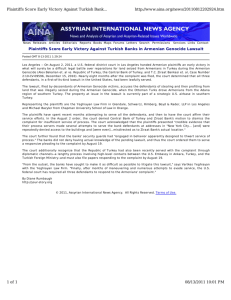
![[Click and Enter Attorney Name], State Bar No - E](http://s3.studylib.net/store/data/007177564_1-4d9407aff5e1ecb2a5922cd955484ee2-300x300.png)


